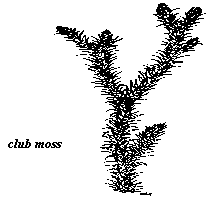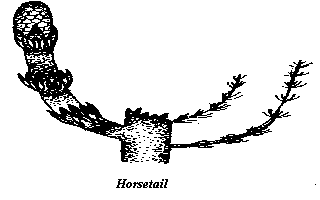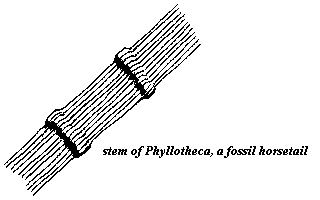Tracheophytes
(Greek ‘trachea’ = windpipe, ‘phyta’ = plant).
Phylum Tracheaphyta.
These are vascular plants.Vascular plants without seeds
Groups include:
• fork ferns (Psilopsids)
• club mosses (Lycopods)
• horsetails
• ferns
Fossils evidence suggests that some groups formed dominant flora in the past. Today ferns are prominent in some cool, moist areas.
- direct descendants of earliest land plants; fossils of their relatives are 410 million years old (late Silurian period)
- Terrestrial or epiphytic
- instead of roots have rhizomes (underground stems with many rhizoids)
- forked stems with very simple vascular tissue
- spore cases form at tips of short branchs
- only two genera known
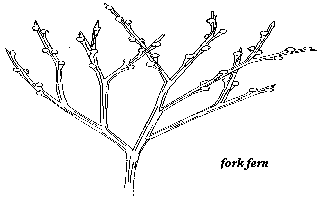
Club mosses (e.g. Huperzia species)
(previously known as Lycopodium species)
- prostrate, branching stem with upright branches
- simple vascular systems
- spore-bearing leaves arranged in cones in some species
- motile sperm (male gametes)
Horsetails
- roots, jointed stems and small leaves arranged in a circle around each stem joint
- spore cases resembling cones found on stems
- motile sperm
- today found only in the Northern Hemisphere
- fossil horsetails, Phyllotheca, found in Australia in rocks of Permian period
Ferns
- rhizomes (underground stem), roots and leaves
- vascular tissue grouped in strands (bundles)
- leaves bear spores in sporangia
- gametophyte is heart-shaped, small, green and completely independent
- motile sperm
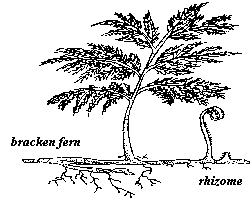
for details in reproduction of ferns see separate sheet

![Director of National Parks [logo]](../images/dnp_90px.gif)


